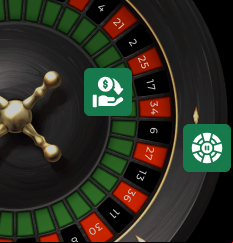How Does The Fibonacci Roulette System Work?
Let’s begin by considering the initial 10 digits of the Fibonacci sequence:
0, 1, 1, 2, 3, 5, 8, 13, 21, 34
As we are using this sequence for betting purposes, we will eliminate the first number, the 0, resulting in the sequence:
1, 1, 2, 3, 5, 8, 13, 21, 34
In the Fibonacci system, each following number, or, in our case, bet, equals the total sum of the two previous numbers.
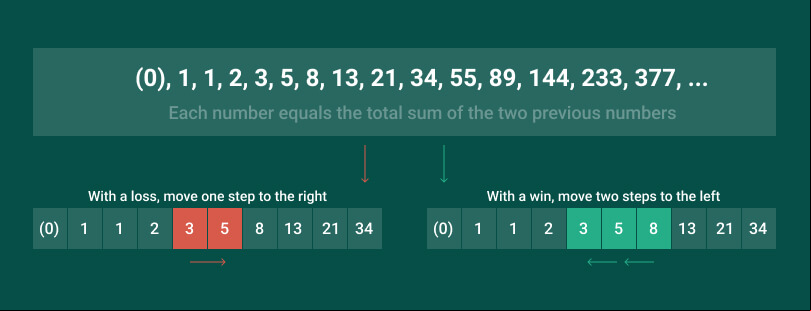
An important rule to follow when using this system for roulette is that it only applies to even money bets, such as Red/Black, Odd/Even, and High/Low in roulette.
To start, we will place an AU$1 bet, which is the first number in the Fibonacci sequence when we exclude the zero. In the event that the bet loses, we will again place a AU$1 bet to maintain the sequence. For example, if this bet loses again, we will increase our bet to the next number in the sequence, AU$2 (since 1+1=2). If this bet also loses, we will move on to the next number, AU$3, and so on, increasing the bet to AU$5, AU$8 and so on as per Fibonacci sequence.
According to the strategy, if a bet wins, we shift down two numbers. So, let’s say that we place a bet of AU$8 and it wins. We then shift back two numbers, which, in our case, is AU$3. If that bet wins again, we shift back to AU$. If the AU$3 bet loses, however, we wager the next number on the list - which is AU$5. Let’s see how the strategy works in practice.
- Spin 1
We place a AU$1 bet and win. We will continue to use a AU$1 stake for the next bet to maintain the sequence.
- Spin 2
The bet is not successful. The system calls for a AU$2 wager on the next round.
- Spin 3
The bet is lost once again. The system dictates that we should place a AU$3 bet on the next round.
- Spin 4
We lose the bet again, so we must place a AU$5 bet on the next round.
- Spin 5
The bet is not successful, and, according to the Fibonacci system, we increase the wager to AU$8.
- Spin 6
The bet is successful. We decrease the stake by two levels, returning to a AU$3 wager.
- Spin 7
The bet is not successful, we increase the stake to AU$5 again.
- Spin 8
The bet is successful. We decrease the stake by two levels, returning to a AU$2 wager.
- Spin 9
The bet is successful. We return to our original base stake of AU$1. With this, we’ve completed a cycle.
Testing The Fibonacci System for Roulette
To evaluate the effectiveness of this system, we conducted an experiment using Google Sheets to simulate 500 rounds of roulette. The probabilities of losing and winning were set to 52.4% and 48.6%, respectively, based on the house edge. We decided to use three hypothetical players for this experiment.
We then utilized the JavaScript programming language to simulate the progression of the game according to the Fibonacci sequence, while maintaining the current bet amount and bankroll status for each step. Based on the collected data, we generated graphs to show the changes in bet and bankroll over time.
This is how Player 1 performed:
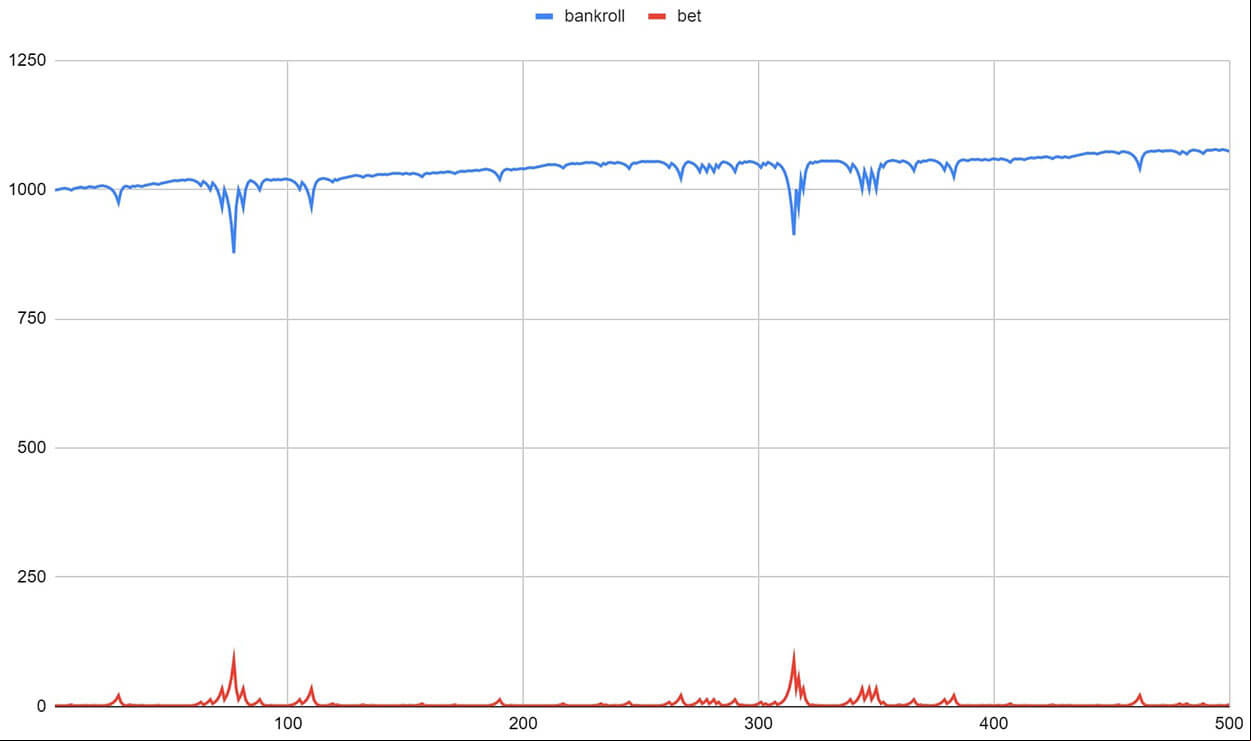
The progression is barely noticeable, and the player ended the 500 spins with a bankroll of AU$1074, and a total gain of AU$74. The maximum bet was AU$89, and it occurred two times during the 500 spins. The lowest point that the bankroll reached was AU$877.
Let’s check out how Player 2 did:
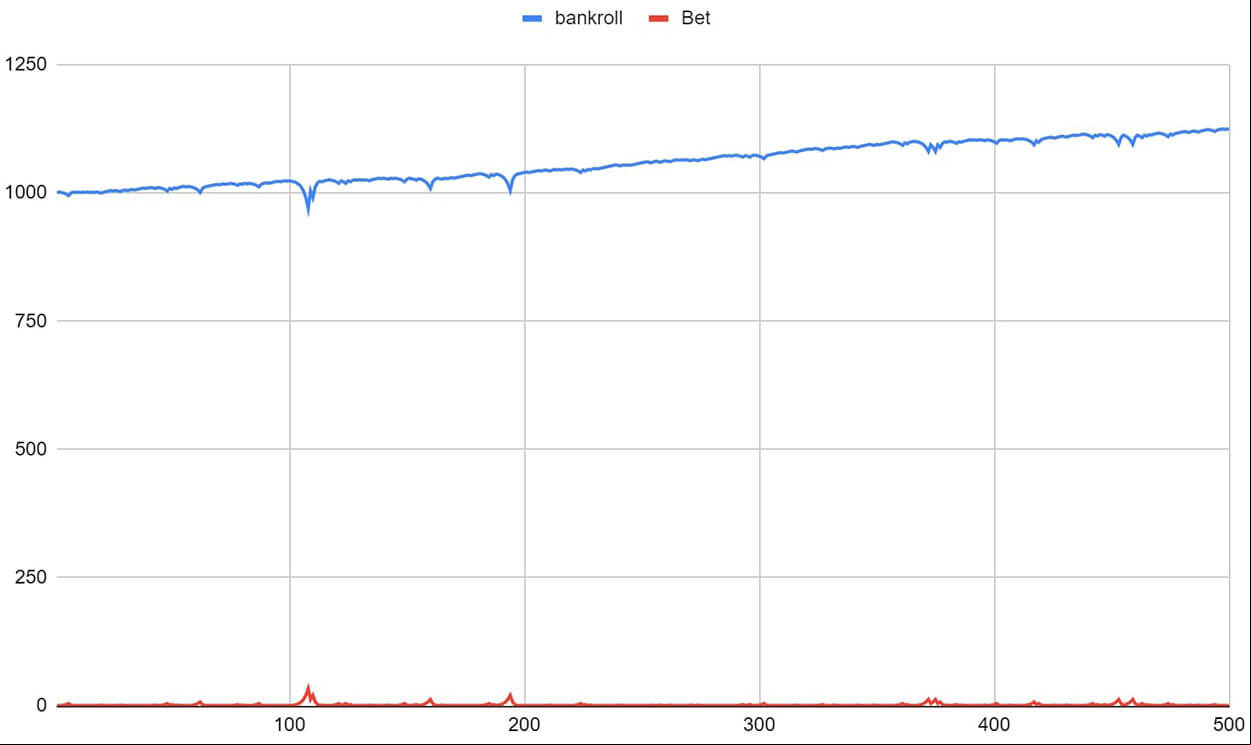
Player 2 also finished the 500 turns with a profit, with a bankroll of AU$1124, out of which AU$124 are profit. They didn’t experience large drawdowns in the bankroll as well.
Now this is how Player 3 performed:
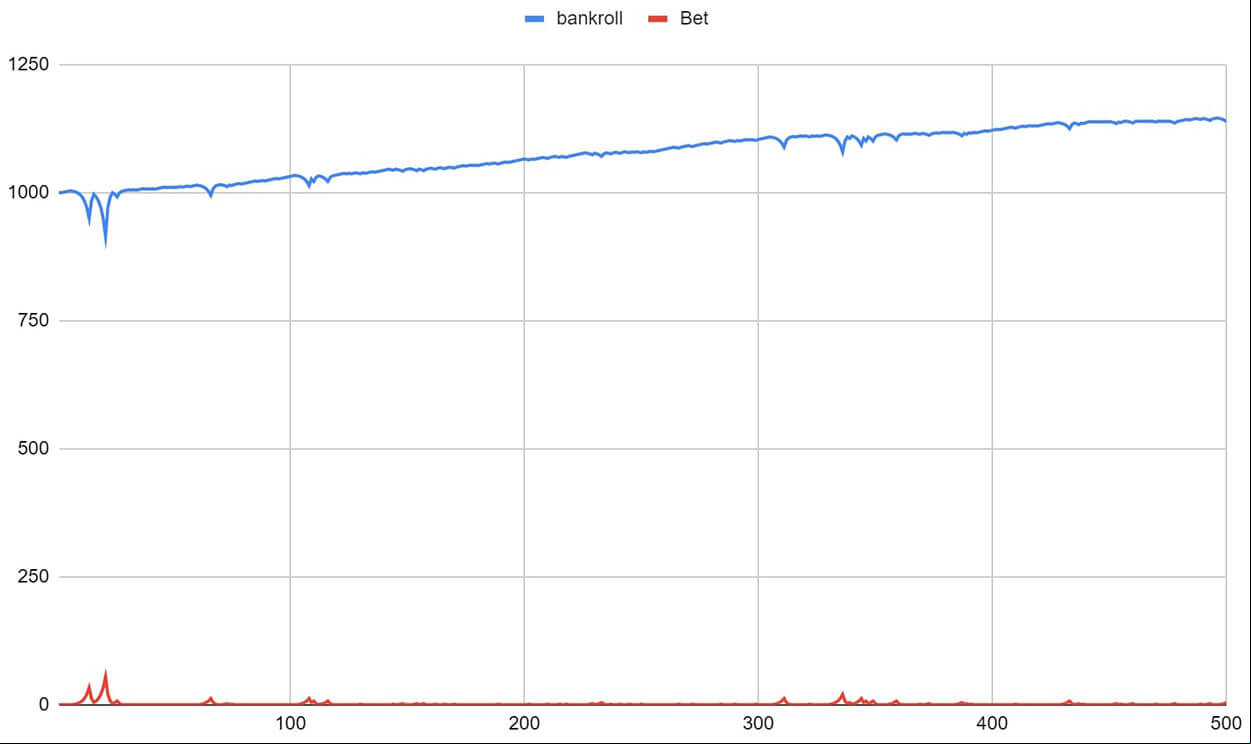
In the end, there were no significant decreases in the bankroll of Player 3 either, and they finished the game with a bankroll of AU$1139.
The experiment's results show that all three players who strictly adhered to the Fibonacci progression successfully completed their games with a profit. Any decreases in the bankroll were offset by subsequent winning moves.
In theory, there could have been a progression deadlock due to reaching the limits or insufficient bankroll, but this did not occur in the experiment. It would have taken 14 consecutive losses for the lack of funds to become an issue, but the probability of that outcome is very small at 0.524^14. The following table shows the sequence through which one might reach a point of insufficient bankroll when starting with 1000 units.
| Bet |
Status |
Bankroll Status |
| 1 |
loss |
999 |
| 1 |
loss |
998 |
| 2 |
loss |
996 |
| 3 |
loss |
993 |
| 5 |
loss |
988 |
| 8 |
loss |
980 |
| 13 |
loss |
967 |
| 21 |
loss |
946 |
| 34 |
loss |
912 |
| 55 |
loss |
857 |
| 89 |
loss |
768 |
| 144 |
loss |
624 |
| 233 |
loss |
391 |
| 377 |
loss |
14 |
Potential Drawbacks of the Fibonacci System
Some sources may inaccurately assert that the Fibonacci betting system is dangerous because of the possibility of swift bankroll depletion and betting limits. However, as our test demonstrates, this is not necessarily true. However, if you have a relatively small bankroll, hitting the limit can become an issue. For example, if you only have AU$100, you will be unable to continue if you experience eight consecutive losses. This potential drawback is not unique to the Fibonacci system and can be found in other betting systems as well.
This system is considered to be a moderate progression system, and the risks are minimal - but the profits are barely noticeable as well. The only potential issue is that it may take a longer time to achieve a significant profit in real-world conditions, which can make the game less enjoyable.
Final Thoughts
So, we put the Fibonacci system to the test on three players and tracked the progress of their games. As you can see, due to the specifics of the algorithm, the bet size didn't get too high. It reached a maximum of AU$89 for one of the players. When we lose, we move up one step and when we win, we move two steps down, which keeps the bet size relatively stable throughout the game.
Going beyond the permitted table limits is highly unlikely, given that the bet limits on outside bets are generally high. However, you should still keep an eye on them as low-limit tables can restrict your maximum bet capability. Moreover, having an insufficient amount to compensate for the losses is only possible if you have a small bankroll - which is why we recommend a starting bankroll of 1000 units. However, even with a bankroll of AU$100 you can absorb eight consecutive losses, which is a rare streak of bad luck. Still, a larger bankroll will lower the risks even further.
It is unlikely that Fibonacci anticipated that his sequence would be used as the foundation for a widely used roulette strategy, but it’s now considered one of the safest Martingale system. However, while it is possible to achieve a small profit over a long period, it requires discipline and financial resources to follow the progression for a hundred or more turns.












